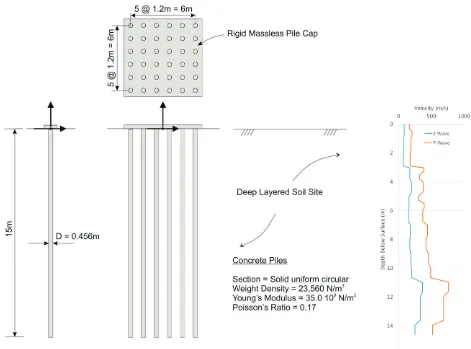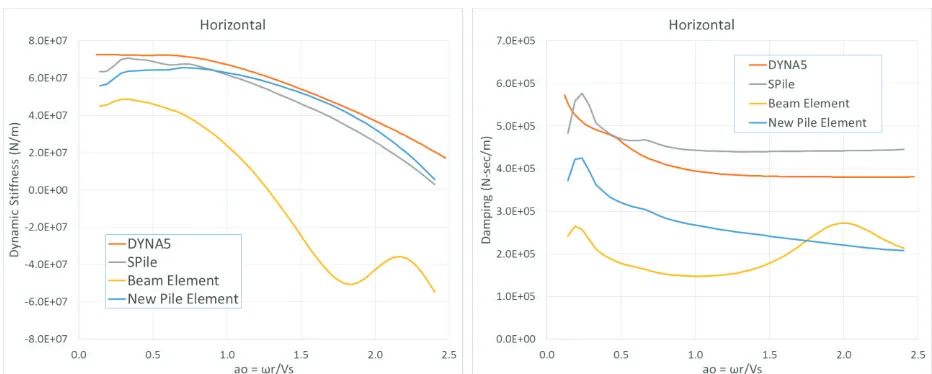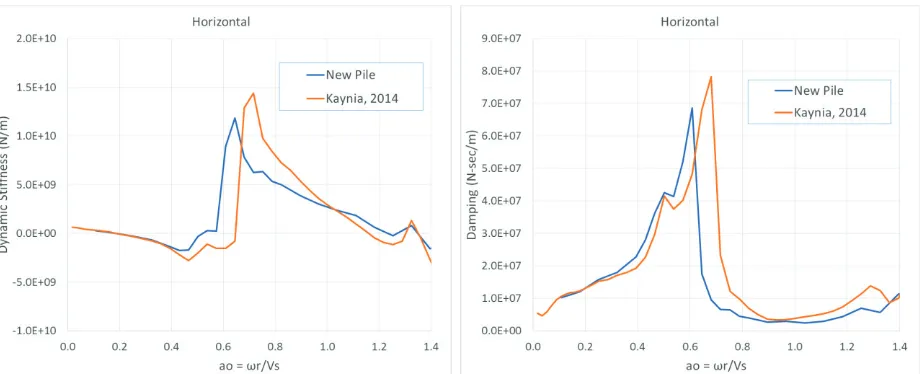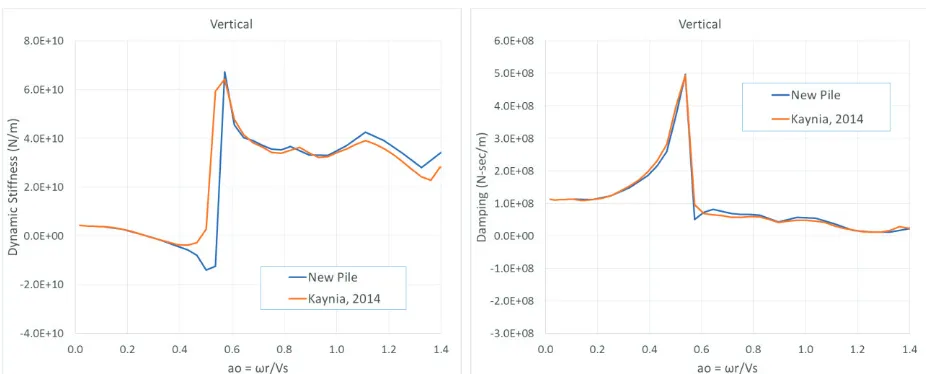DYNAMIC IMPEDANCE OF LARGE PILE-GROUP FOUNDATIONS
Mansour Tabatabaie1
1Principal Engineer, MTR & Associates, USA
ABSTRACT
Dynamic response analysis of pile-supported structures in SASSI is relatively complex and requires proper modeling and knowledge of pile-soil-structure interaction. The original hybrid pile procedure implemented in SASSI requires a large number of interaction nodes that makes it unappealing for practical applications. The Spile methodology, developed from the point load solution of an axi-symmetric pile model in SASSI, provides accurate results for a single pile analysis but cannot be easily extended to large pile groups. As a result, the current practice in SASSI is to use Beam elements to model pile groups.
A recent benchmark study to evaluate the adequacy of Beam element to model pile groups in SASSI has revealed severe deficiencies in this procedure for such applications. To overcome the deficiencies of Spile and Beam elements, a new Pile element has been developed and implemented in SASSI. This paper examines the results of Spile, Beam and new Pile element procedures by comparing the dynamic impedance of a fixed-head single pile and 6x6 pile group with rigid pile cap in a layered soil system to a frequency of 50 Hz. With DYNA5 providing a targeted solution for single pile and Kaynia, 2014 for the 6x6 pile group, the significant improvement in the results using the new pile element procedure is evident. The results are then extended using the new Pile element to a large pile group to examine the effect of pile-soil-pile interaction.
INTRODUCTION
Pile foundations are often required to transfer the loads of large structures to competent bearing materials below the ground surface and to minimize foundation settlements. For majority of ordinary structures supported on piles, the dynamic response of structures are calculated using static foundation springs developed from lateral and vertical analysis of a single pile incorporating modulus of subgrade reaction (P-Y and T-Z springs) or from simplified strain wedge analysis. For critical structures, however, such as nuclear plants, on-shore LNG tanks and offshore oil production platforms, it is often necessary to consider the dynamic effects due to seismic or dynamic loads. For large machine foundations with resonant frequencies falling in the range of operating frequencies of the machinery (generally in the 30 to 80 Hz), it is also necessary that the dynamic effects of the response be adequately evaluated for proper design and sizing of the foundations. The results and discussions in the present study pertain to dynamic response of small diameter (d = 0.3-0.76 m) and relatively flexible piles (L/d > 20 where L is the pile length and D is pile diameter) for which lateral pile behavior is controlled primarily by flexural rather than shear stiffness.
BACKGROUND
23rd Conference on Structural Mechanics in Reactor Technology Manchester, United Kingdom - August 10-14, 2015 Division V
a set of uncoupled springs and dashpots that represent the dynamic stiffness of the foundation (generally referred to as lumped parameter foundation model). These foundation springs and dashpots are then used as boundary condition for dynamic response analysis of the structure. To address the effects of soil nonlinearity in the vicinity of the piles especially near the ground surface where even small loads can cause yielding of the soil or slips and separation between the soil and pile, satisfactory solutions can be obtained by incorporating nonlinear static springs arranged in parallel with the linear foundation dynamic springs and dashpots. Nonlinear springs calibrated from field pile load tests are available for different soil types or can even be developed theoretically from nonlinear static load analysis. The linear dynamic foundation springs and dashpots, in general, are obtained from numerical analysis of pile foundations, as discussed below. As an alternative to nonlinear static springs, a circular annulus of degraded soil zone around the piles may be included in the pile foundation model to account for soil nonlinearity in the vicinity of the piles.
For a single pile in a layered soil system, rigorous analytical solutions in the form of frequency-dependent springs and dashpots (dynamic impedance) have been developed using both continuum and finite element methods. In the case of pile groups, only limited rigorous analytical solutions for dynamic impedance functions are available. This is primarily due to the size of pile group that requires significant numerical effort to rigorously solve for the effects of dynamic interaction between individual piles.
OVERVIEW OF PILE GROUP ANALYSIS
Wolf and Von Arx (1978) presented results of dynamic impedance for a pile foundation with 100 piles. This solution was obtained by first solving a single pile problem for layered soil system using an axi-symmetric finite element model with non-reflecting lateral boundaries. The results were then used to construct a dynamic flexibility matrix by superposition and then inverting this matrix to calculate the pile group impedance. It is reported from their findings the pile-soil-pile interaction is important for all modes of vibration and the interaction may be effective up to 10 to 100 pile diameters for the horizontal and vertical vibration, respectively.
Novak and Aboul-Ella (1978) derived dynamic stiffness and damping for a single pile based on the dynamic soil reactions to pile displacements assuming that soil consists of infinitely thin layers extending horizontally to infinity. The methodology is best suited for high frequencies. In the low frequency range, as the frequency approaches zero, the horizontal and vertical soil stiffness become zero. To correct for this, the theory is modified to match more rigorous solutions by choosing a minimum cutoff frequency below which the soil stiffness is taken as constant and the damping is taken as linear. For pile groups, the foundation stiffness and damping are then calculated by superposition method (Novak and Mitwally, 1990) in which the interaction between each two piles is used to derive the flexibility matrix from which the group stiffness and damping are calculated. The interaction between two piles are obtained by curve-fitting to the published static and dynamic group factors available in the literature for small pile groups. This procedure has been implemented in DYNA5 program. It is noted that the accuracy of this procedure for large pile groups is dependent on the group factors formulated from published results.
pile groups. Nonetheless, the accuracy of this methodology for application to large pile groups is not known.
Kaynia (1982, 2012) has presented results of dynamic impedance for a single pile and small (4x4 and 8x8) pile groups in homogeneous soil layer as well as 6x6 pile groups in layered soil system (Kaynia, 2014). In this formulation, the pile-soil tractions are replaced with piecewise constant cylindrical loads on
the pile shafts and pile tips, then Green’s functions for these loads are used to solve for the soil stiffness matrix at soil/pile interaction nodes, and finally the resulting soil stiffness matrix is couple with the dynamic stiffness of the piles and solved. While this analytically-driven Green’s functions solution is rigorous, the numerical effort to solve for large pile groups can be significant. It is noted that no results of
application of Kaynia’s procedure to large pile groups are reported in the literature.
SASSI PROCEDURE FOR PILE GROUP ANALYSIS
The purpose of this paper is to examine the currently available procedures for dynamic analysis of pile groups in SASSI (Lysmer, et. al.) and present a new pile element procedure for accurate and effective analysis of large pile groups.
Hybrid Element Procedure
A hybrid finite element procedure is available in SASSI for dynamic response analysis of pile groups. It consists of a linear beam element that models the stiffness and mass of the pile connected to inter-pile elements that model the soil between the piles. The pile foundation zone is discretized using this hybrid element and the SSI analysis is performed within the framework of the Flexible Volume Method in SASSI. The advantage of this method is that soil within the piles are directly modelled so their properties can be controlled. The main disadvantage of this procedure is that it requires a large number of interaction nodes to model large pile groups, and as a results its use has been limited to small pile groups in practice.
Single Pile Procedure
Single pile or Spile procedure in SASSI is based on the solution of a single vertical pile embedded in layered soil system using an axi-symmetric finite element model and non-reflecting lateral boundaries. The pile can have free-head (non-zero rotation) or fixed-head (zero rotation) condition at the top. A harmonic force with unit amplitude is applied separately in the global x-, y- and z-direction to the pile head and the resulting displacements in the x-, y- and z-directions at all interaction nodes (basically top of the piles connecting to rigid pile cap) are calculated. The results from all piles in the group are then superimposed and used to construct a complex-valued flexibility matrix. This matrix is then transformed to a 6x6 constrained flexibility matrix associated with rigid pile cap and then inverted to calculate 6x6 dynamic impedance matrix for each frequency of vibration. Spile procedure provides rigorous solution for a single pile. It is also a fast and quick procedure to derive dynamic impedance of pile groups. However, when applied to large pile groups, its accuracy appears to quickly deteriorate because it does not account for the kinematic interaction between individual piles. This will be further discussed below.
Beam Element Procedure
23rd Conference on Structural Mechanics in Reactor Technology Manchester, United Kingdom - August 10-14, 2015 Division V
the piles are lumped at pile nodes. Both vertical and battered piles with rigid or flexible pile cap can be modeled. Soil nonlinearity can be accounted for by modeling a circular annulus soil zone next to piles with solid elements. The properties of these elements can then be adjusted or iterated on using equivalent linear method. Recent studies of dynamic impedance of single pile developed using the Beam element procedure in SASSI shows significant departure from the single pile solution which make it unattractive for application to large pile groups. This discrepancy is attributed to the fact that the pile radius is ignored in deriving the traction forces on the pile.
New Pile Element Procedure
To address the inadequacies of Spile and Beam element procedure in SASSI to model dynamic response of large pile groups, a new pile analysis procedure has been developed and implemented in MTR/SASSI. The new procedure is based on a new formulation of pile element and derivation of traction forces on pile shafts and tips. The new procedure can handle piles with both the rigid or flexible pile caps and can be used with any foundation configuration. The soil nonlinearity can be accounted for by modeling a circular annulus soil zone around the piles with solid elements and including them as part of the foundation model. The properties of these elements can then be adjusted or iterated on using equivalent linear method. The accuracy and effectiveness of the new Pile element procedure are investigated in this paper.
DYNAMIC RESPONSE OF SINGLE PILE AND 6X6 PILE GROUP
To evaluate the accuracy of pile group analysis in SASSI, the horizontal and vertical dynamic stiffness and damping of a single pile and 6x6 pile group founded in a deep layered soil profile are calculated using the Spile, Beam and new Pile element and the results are compared against those obtained from DYNA5 for the single pile and Kaynia (2014) for the 6x6 pile group.
Two analysis cases were considered -- case1 consists of a single floating pile with fixed-head condition and Case 2 consists of a 6x6 floating pile group with a rigid massless pile cap at the top. The foundation stiffness and damping functions refer to the top of the single pile and center of pile cap for the 6x6 pile group at the ground surface. Figure 1 shows the pile foundation configuration and properties for the single pile and 6x6 pile group.
The piles have uniform solid circular cross section of diameter d = 0.456m and same embedment length of L = 15m (L/d = 33). The spacing of the 6x6 pile group is S = 1.2m center-to-center (S/d = 2.6). The soil velocity profile is shown in Figure 1. The soil has a weight density of 19,000 N/m3 and material damping of 0.02.
The foundation impedance is presented as:
K(ω) = k(ω) + i ao c(ω) (1)
Figure 1. Single Pile and Pile Group Configuration and Properties
Results and Discussions
Single Pile Response:
Figure 2 and 3 show the results of the single pile obtained from MTR/SASSI using the Spile, Beam Element and new Pile procedure compared with each other and with the target results from DYNA5 for the horizontal and vertical loading, respectively. In general, the Spile and new Pile element results show good agreement with those of DYNA5 except for the horizontal damping where the Spile and new Pile element results are lower than DYNA5 results. It is recommended that the damping values calculated by DYNA5 be reduced by a factor of 2 for design, which would bring DYNA5 horizontal damping values closer to those calculated from Spile and the new Pile element procedure in SASSI.
23 Conference on Structural Mechanics in Reactor Technology Manchester, United Kingdom - August 10-14, 2015 Division V
Figure 2. Dynamic Impedance of Single Pile in Deep Layered Soil, Horizontal Loading
Figure 3. Dynamic Impedance of Single Pile in Deep Layred Soil, Vertical Loading
Pile Group Response:
Figure 4. Dynamic Impedance of 6x6 Pile Group in Deep layered Soil, Vertical Loading (Spile vs. Kaynia)
Comparisons of horizontal and vertical dynamic stiffness and damping for the 6x6 pile group calculated using the new Pile element procedure in MTR/SASSI and those of Kaynia, 2014 are shown in Figure 5 and 6, respectively. As show in Figure 6 there is very good agreement between the new pile procedure and Kaynia’s results for the vertical loading at all frequencies. For the horizontal loading shown in Figure 5 the overall shape of the stiffness and damping functions for the new Pile procedure match those of Kaynia’s solution relatively well except that the peak of stiffness and damping functions are shifted slightly to lower frequencies with the peak amplitude slightly lower. Because the frequency of the peak is
associated with the soil velocity and spacing of the piles, it appears that in Kaynia’s solution, the point of
fixity of the pile is deeper so that higher velocities are sampled from deeper depths and/or the effective spacing of the piles is smaller than that of the new pile procedure. In either case the difference between the two results is not large and is generally covered by peak broadening considering variations in soil properties for design.
Figure 5. Dynamic Impedance of 6x6 Pile Group in Deep layered Soil, Horizontal Loading (New Pile vs. Kaynia)
23 Conference on Structural Mechanics in Reactor Technology Manchester, United Kingdom - August 10-14, 2015 Division V
Figure 6. Dynamic Impedance of 6x6 Pile Group in Deep layered Soil, Vertical Loading (New Pile vs. Kaynia)
DYNAMIC RESPONSE OF LARGE PILE GROUP
To evaluate the effects of number of piles on dynamic response of pile groups, one additional case of 11x11 pile group with rigid pile cap at the top was analyzed. For this, the same piles with same soil profile and pile spacing was used. The SASSI pile model is basically the same as that shown in Figure 1 except that it incorpoates two vertical planes of symmetry at the center of pile group, and adjusts the pile properties on the symmetry planes. This effectively increases the size of the model from 6x6 to 11x11 pile group. The numerical effort is only slightly more than that of the 6x6 pile group model.
Results and Discussions
Comparison the dynamic impedance for the 6x6 versus 11x11 pile group normalized with respect to the total number of piles is shown in Figure 7 and 8 for the horizontal and vertical loading, respectively. An inspection of the results shown in Figure 7 reveals very comparable effective horizontal stiffness and damping from two models except for the value of dominant peak of the pile group which is lower for the 6x6 pile group. It is noted that even the frequency of the peaks and valleys match very well between the two models, which as stated before is due to the fact that the effective soil velocity and spacing of the piles are the same for both models as the number of piles increases.
Figure 7. Comparison of Normalized Dynamic Impedance of 6x6 and 11x11 Pile Groups in Deep layered Soil, New Pile Procedure, Horizontal Loading
Figure 8. Comparison of Normalized Dynamic Impedance of 6x6 and 11x11 Pile Groups in Deep layered Soil, New pile Procedure, Vertical Loading
CONCLUSION
The available procedures for dynamic analysis of pile groups in SASSI were briefly reviewed. Among these only the Spile, Beam and a newly developed Pile procedure are capable of solving large pile groups. The accuracy of these procedures were evaluated by comparing the horizontal and vertical dynamic impedance of a single pile and 6x6 pile group founded in a deep layered soil profile with those obtained from DYNA5 and Kaynia, 2014. Based on these comparisons, it is concluded that:
· The use of Beam element procedure to model single pile in SASSI results in dynamic stiffness and damping that significantly deviate from target solutions at all frequencies.
23rd Conference on Structural Mechanics in Reactor Technology Manchester, United Kingdom - August 10-14, 2015 Division V
· The new Pile procedure results in dynamic stiffness and damping for the single and 6x6 pile group that agree reasonably well with those of other rigorous solutions.
The effect of number of piles on dynamic response of pile groups was evaluated by comparing the normalized dynamic stiffness and damping of a 6x6 and 11x11 pile group founded in the same soil profile using the new Pile procedure in MTR/SASSI. The normalized dynamic stiffness and damping of 11x11 pile group are found to converge to those of the 6x6 pile group at all frequencies except for some differences at and below the frequency of dominant mode of foundation.
ACKNOWLEDGEMENT
The author would like to acknowledge the contribution of Dr. Fredrick Tajirian of Chevron USA who provided the data used in this study. The author is also grateful to Dr. Amir Kaynia of NGI who provided independent results for the 6x6 pile group with permission to use for comparison on this study.
REFERENCES
Kaynia, A. M. (1982), “Dynamic Stiffness and Seismic Response of Pile Groups,” Research ReportR82-03, Dept. Civil Eng., M.I.T., Cambridge, Massachusetts, USA.
Kaynia, A. M. (2012), “Dynamic Response of Pile Foundations with Flexible Slabs,” Journal of Earthquakes and Structures, Vol.2, No. 3-4, USA.
Kaynia, A. M. (2014), “Dynamic Stiffness and Damping of 6x6 Pile Group in Layered Soil,”
Unpublished (with permission from author).
Lysmer, J., Tabatabaie, M., Tajirian, F., Vahdani, S. and Ostadan, F. (1981). “SASSI – A System for Analysis of Soil-Structure Interaction,” Report No. UCB/GT/81-02, Geotechnical Engineering, Department of Civil Engineering, University of California, Berkeley, USA.
MTR/SASSI (2015). “System for Analysis of Soil-Structure Interaction,” Version 9.4.6.7, MTR & Associates, Inc., Lafayette, California.
Novak, M. And Aboul-Ella, F. (1978), “Stiffness and Damping of Piles in Layered Media,” Proc. Earthq. Engrg. And Soil Dyn., ASCE Specialty Conf., pp. 704-719, Pasadena, California, USA.
Novak, M. And Mitwally, H. (1990). “Random Response of Offshore Towers with Pile-Soil-Pile
Interaction,” Journal of Offshore Mechanics and Arctic Engineering, Vol, 112, pp. 35-41, USA.
Tabatabaie, M. (2014). “SASSI FE Program for Seismic Response Analysis of Nuclear Containment Structures,” Chapter 22: on Infrastructure Systems for Nuclear Energy, John Wiley & Sons Ltd.




